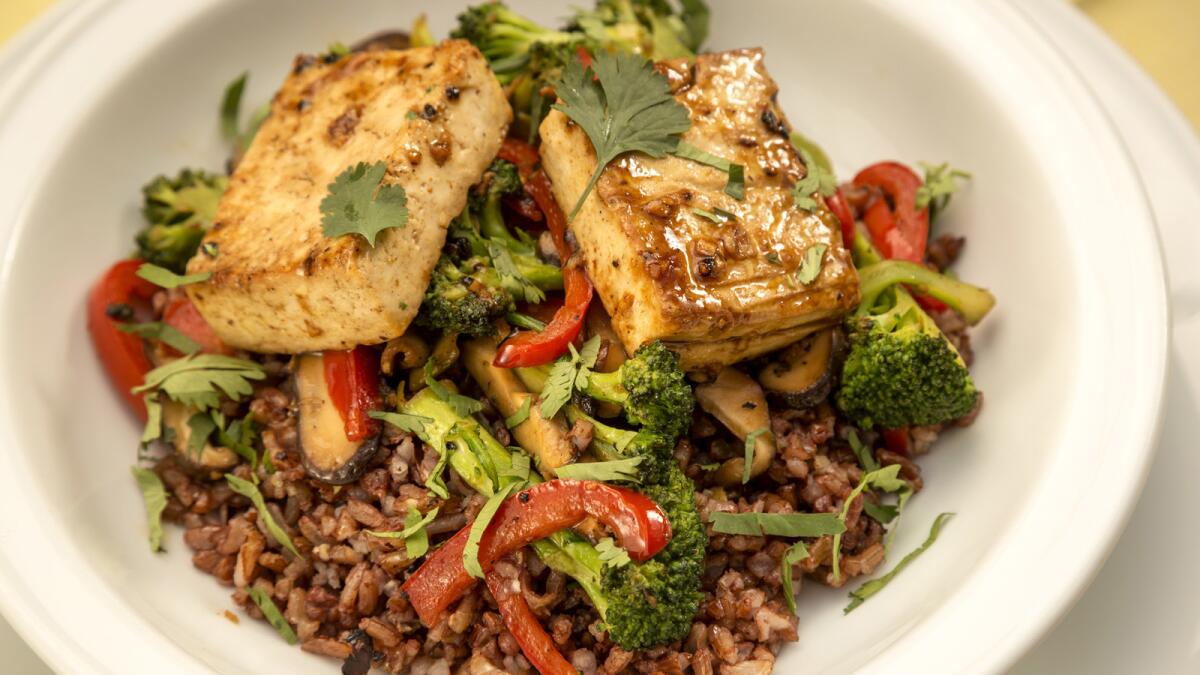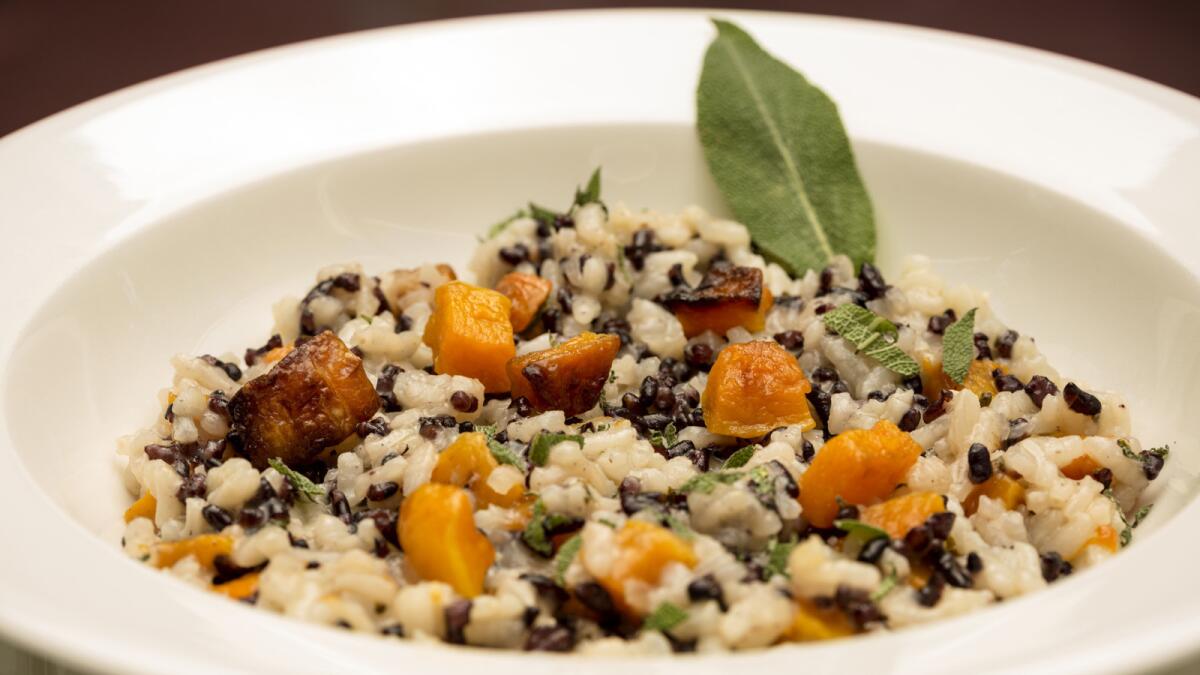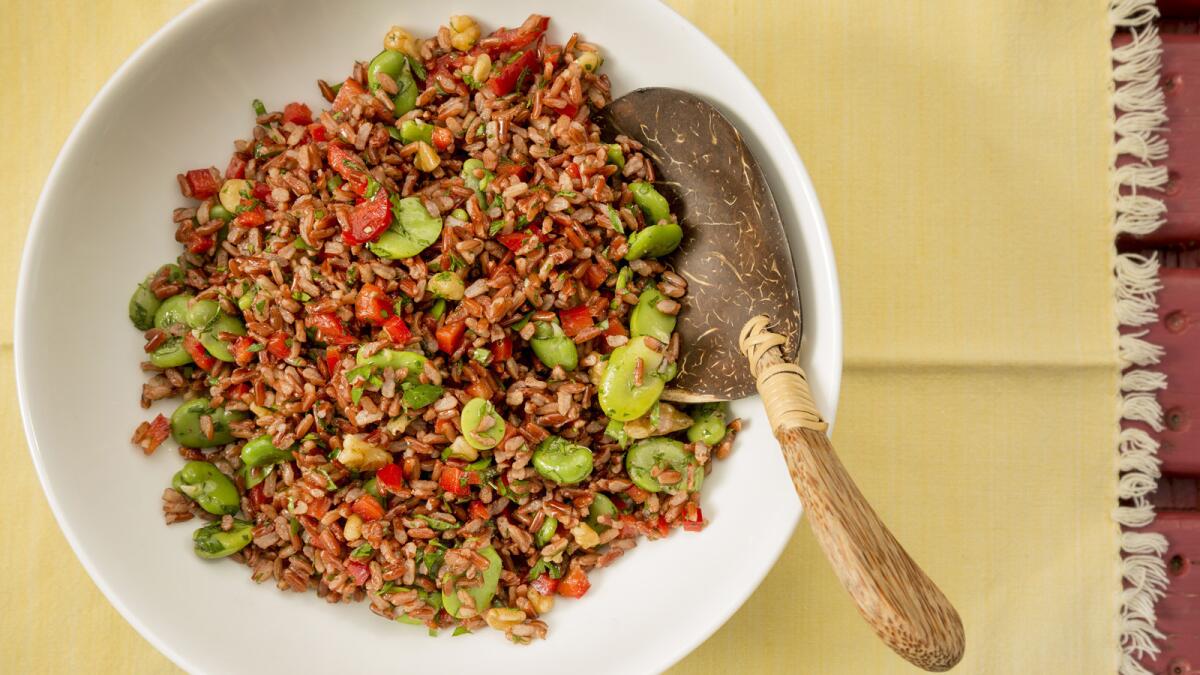Beyond brown rice: How to make rice bowls out of specialty rice

There was a time when whole-grain rice meant one thing: brown rice, long grain or short. Eventually, brown basmati hit the market, but those choices pale in comparison to what we can find on supermarket shelves and online today. Now we can cook with an array of specialty whole-grain rice that comes from near and far, in a variety of textures and a multitude of colors — from tawny to pink and a darker crimson, to shades of purple and black, which is notably gorgeous on the plate.
These beautiful and nutritious rices — their dark, berry-like pigments carry a particular type of flavonoid called anthocyanins that have strong antioxidant properties — are like exciting new grains, but they are all decidedly rice, with nutty, sometimes earthy flavors, not unlike brown rice. However, they’re more nuanced and tender than brown rice; their hulls are softer and in some cases cracked; and they absorb flavors really well.
Specialty rices — or unique varieties, not rice mixes or flavored rice — have been available for several years now, thanks to a number of socially conscious and innovative companies that are not only devoted to whole grains but are also committed to fair trade and to sustainable, responsible farming. Some of the rice is grown in California, in the Sacramento Valley. Other brands come from farther afield: Thailand, Bhutan, China, Madagascar and the Philippines. You can taste a number of those last varieties at Charles Olalia’s Filipino counter restaurant Rice Bar in downtown Los Angeles. And what you can’t find in supermarkets and Whole Foods are easily purchased online — just do an online search for “specialty rice.”
Recipe: Garlic fried rice bowl with baked marinated tofu and stir-fried vegetables »
All the brands that I’ve worked with come with cooking instructions on their packaging that give you water-to-rice ratios, and for the most part these are reliable, although in some cases you might find that the rice is ready to eat before it has absorbed all of the water. Then simply drain the rice and return it to the pot to stand. With the exception of two or three brands that took 45 to 50 minutes to cook, most of the red, tawny and purple varieties cook in 25 to 35 minutes. The cooking time for black rice ranges from 30 minutes to 45. Some package instructions suggest soaking the rice first, for about 30 minutes.
You can also use a rice cooker, with the same proportions of water to rice suggested for stovetop cooking. (The package instructions say that you may need to add a few tablespoons of extra water if the rice is still crunchy at the end of cooking.)

Recipe: Black pearl and arborio risotto with roasted butternut squash »
When you cook rice — or any other grain — you’ll achieve the driest, fluffiest results if you follow this method that I learned from my friend and colleague Clifford A. Wright. Once the rice is cooked, drain it if necessary and return it to the pot, then place a dish towel tightly across the top of the pot and return the lid. After 10 to 15 minutes, fluff the rice. The towel absorbs steam and the rice will be nice and dry.
When I cook specialty rice, it becomes the focal point of my meal. At its simplest, I toss plain steamed or garlic-fried rice with roasted vegetables. One of my favorite no-fuss combinations is roasted squash with black rice, which is pretty stunning to look at, as well as to eat. Peel and dice the squash, toss it with olive oil and salt, and roast it on a parchment-covered baking sheet at 425 degrees until tender. Then toss the roasted squash with the rice for a very simple rice bowl. You can do the same with roasted halved Brussels sprouts, which are beautiful with both black and red rice. Stir-fries and rice bowls can accommodate all the different specialty-rice varieties, and make a particularly good home for the stickier types.

Recipe: Red rice salad with favas, walnuts and red peppers »
When you want to use specialty rice in a risotto, it’s best to combine it with arborio rice rather than use it exclusively. Red rice and black rice aren’t starchy like the traditional Italian arborio rice used for risotto, and take longer to cook. Cook the specialty rice ahead, begin the risotto using arborio to get a creamy consistency, and shortly before it’s done stir in the cooked specialty rice — black rice looks especially beautiful. And since the arborio rice is slightly softer, you’ll get a contrast of textures as well as colors.
Salads with tart, somewhat lemony vinaigrettes make great vehicles for colorful whole-grain rice. I like to use varieties with softish grains that don’t get too sticky when they cook; they also absorb dressings particularly well. Several red and tawny rice varieties fall into this category. Any number of vegetables look beautiful against the grains, especially the bright-green fava beans that are now hitting the farmers markets.
These grains are not cheap — they can range in price from about $4 to $6 a pound. But that’s a small price to pay for a food that I’m happy to put at the center of my plate night after night.
ALSO:
Chef Tin Vuong of Little Sister shares tips for making congee
How to make a Sqirl’s super trendy grain bowl with chef Jessica Koslow
A Filipino native who’s cooked for Guy Savoy and Thomas Keller opens Rice Bar in downtown L.A.
More to Read
Eat your way across L.A.
Get our weekly Tasting Notes newsletter for reviews, news and more.
You may occasionally receive promotional content from the Los Angeles Times.









